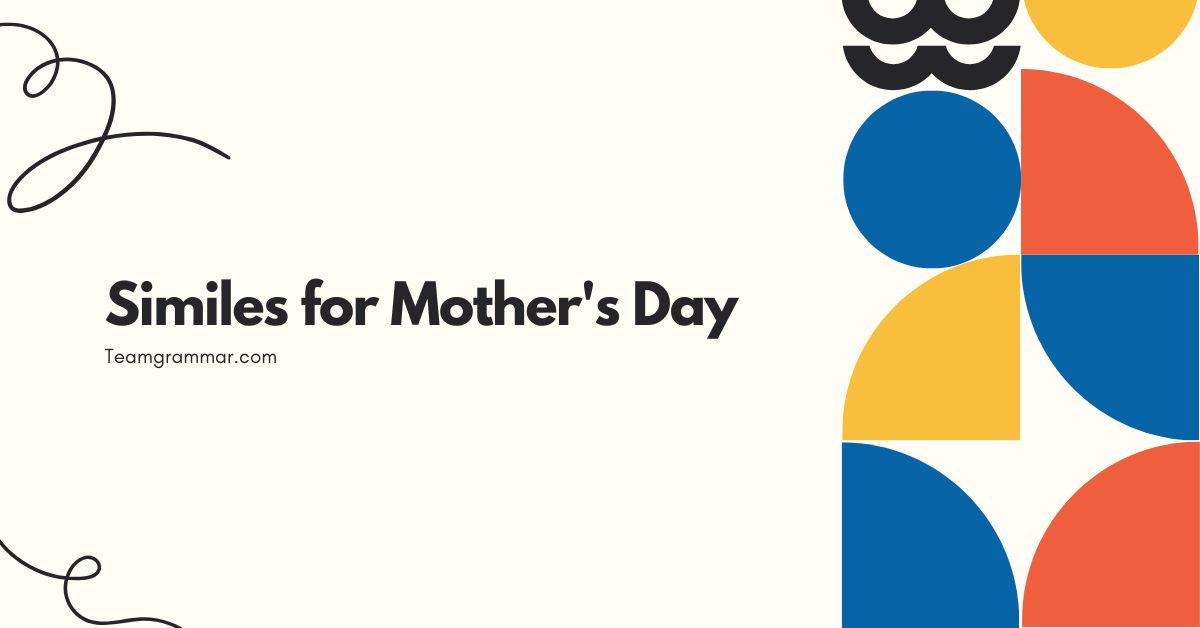49 Similes for Mother’s Day: A Grammatical Celebration
Understanding similes is crucial for adding vividness and depth to your writing and speech, especially when crafting heartfelt messages for occasions like Mother’s Day. Similes, a type of figurative language, allow us to draw comparisons between seemingly unrelated things, creating a richer and more evocative expression.
This article delves into the world of similes, focusing on their structure, usage, and application, particularly in the context of celebrating mothers. Whether you’re a student learning about literary devices, a writer looking to enhance your prose, or simply someone wanting to express their appreciation for their mother in a creative way, this guide will provide you with the knowledge and tools to master the art of crafting meaningful similes.
Table of Contents
- Introduction
- Definition of Simile
- Structural Breakdown of Similes
- Types of Similes
- Examples of Similes for Mother’s Day
- Usage Rules for Similes
- Common Mistakes with Similes
- Practice Exercises
- Advanced Topics in Simile Usage
- Frequently Asked Questions
- Conclusion
Definition of Simile
A simile is a figure of speech that directly compares two different things, typically using the words “like” or “as.” Its primary function is to create a vivid image or enhance understanding by drawing a parallel between the characteristics of the two things being compared. Unlike a metaphor, which implies that one thing *is* another, a simile acknowledges the comparison explicitly.
Similes are powerful tools for writers and speakers because they can make abstract ideas more concrete, add emotional depth to descriptions, and engage the audience’s imagination. They are frequently used in literature, poetry, and everyday conversation to express ideas in a more colorful and memorable way.
The effectiveness of a simile lies in its ability to create a connection between the familiar and the unfamiliar, allowing the audience to grasp the intended meaning more easily.
In the context of Mother’s Day, similes can be particularly effective in expressing the unique qualities and characteristics that make mothers special. By comparing a mother’s love, strength, or kindness to something else, we can create a more meaningful and heartfelt tribute.
Classification of Similes
Similes can be classified based on the type of comparison they make. Some common classifications include:
- Descriptive Similes: These focus on physical attributes or sensory experiences.
- Emotional Similes: These convey feelings or emotional states.
- Abstract Similes: These compare abstract concepts or ideas.
- Action Similes: These compare actions or behaviors.
Function of Similes
The primary functions of similes include:
- Clarification: Making something easier to understand by comparing it to something familiar.
- Emphasis: Highlighting a particular quality or characteristic.
- Imagery: Creating a vivid mental picture for the reader or listener.
- Emotional Impact: Evoking feelings or emotions through comparison.
Contexts for Using Similes
Similes are appropriate in a wide range of contexts, including:
- Creative Writing: In poems, stories, and essays to add depth and imagery.
- Speeches: To make ideas more relatable and engaging.
- Everyday Conversation: To express ideas in a more colorful and descriptive way.
- Formal Writing: While less common, similes can be used in formal writing to clarify complex concepts.
Structural Breakdown of Similes
The basic structure of a simile involves three key components: the tenor (the subject being described), the vehicle (the object or concept to which the subject is compared), and the ground (the shared characteristic between the tenor and the vehicle). The words “like” or “as” act as the bridge connecting the tenor and the vehicle.
The formula for a simile can be expressed as: Tenor + “like” or “as” + Vehicle + Ground (optional). While the ground is often implied, explicitly stating it can enhance the clarity and impact of the simile.
For example, in the simile “My mother’s love is like a warm blanket,” the tenor is “My mother’s love,” the vehicle is “a warm blanket,” and the implied ground is comfort and security.
Tenor
The tenor is the subject of the simile, the thing being described or compared. It is the focal point of the comparison.
In the context of Mother’s Day similes, the tenor is often the mother herself, or some aspect of her being, such as her love, strength, or kindness.
Examples of tenors in Mother’s Day similes:
- My mother’s smile
- Her gentle touch
- Her unwavering support
- My mom’s wisdom
Vehicle
The vehicle is the object or concept to which the tenor is compared. It should be something familiar or easily understood, so that the comparison is clear and effective.
The vehicle provides a new perspective on the tenor, highlighting a particular quality or characteristic.
Examples of vehicles in Mother’s Day similes:
- The sun
- A guiding star
- A gentle breeze
- A sturdy oak tree
Ground
The ground is the shared characteristic or quality between the tenor and the vehicle. It is the basis of the comparison, explaining why the two things are being compared.
While the ground is often implied, explicitly stating it can strengthen the simile.
Examples of ground in Mother’s Day similes:
- Warmth
- Guidance
- Gentleness
- Strength
Types of Similes
Similes can be categorized based on the type of comparison they make. Understanding these different types can help you craft more effective and nuanced similes.
Descriptive Similes
Descriptive similes focus on physical attributes or sensory experiences. They use concrete imagery to create a vivid picture in the reader’s mind.
Example: “My mother’s eyes are as blue as the summer sky.” This simile uses the color of the sky to describe the color of the mother’s eyes, creating a visual image.
Emotional Similes
Emotional similes convey feelings or emotional states. They use comparisons to express emotions in a more relatable and impactful way.
Example: “My mother’s love is like a warm hug on a cold day.” This simile uses the feeling of a warm hug to describe the feeling of the mother’s love, evoking a sense of comfort and security.
Abstract Similes
Abstract similes compare abstract concepts or ideas. They use comparisons to make abstract ideas more concrete and understandable.
Example: “My mother’s wisdom is like a guiding light in the darkness.” This simile uses the image of a guiding light to represent the mother’s wisdom, making it more tangible and relatable.
Action Similes
Action similes compare actions or behaviors. They use comparisons to describe how someone does something in a more vivid and engaging way.
Example: “My mother nurtures me like a gardener tends to her flowers.” This simile compares the mother’s nurturing actions to a gardener tending to flowers, highlighting the care and attention she provides.
Examples of Similes for Mother’s Day
Here are some examples of similes that can be used to express love and appreciation for mothers on Mother’s Day. These examples are organized into categories to help you find the perfect simile for your message.
Similes Describing a Mother’s Love
These similes focus on the depth and quality of a mother’s love, comparing it to various comforting and nurturing elements.
| Simile | Explanation |
|---|---|
| Her love is like a warm blanket on a cold night. | Describes the comforting and protective nature of her love. |
| Her love is as endless as the ocean. | Emphasizes the boundless and unwavering nature of her love. |
| Her love is like a gentle rain, nourishing my soul. | Highlights the nurturing and revitalizing effect of her love. |
| Her love is as bright as the morning sun. | Conveys the warmth and positivity her love brings. |
| Her love is like a safe harbor in a storm. | Portrays her love as a source of security and protection. |
| Her love is as strong as an oak tree. | Highlights the resilience and steadfastness of her love. |
| Her love is like a gentle melody that soothes my heart. | Describes the comforting and peaceful effect of her love. |
| Her love is as pure as a mountain stream. | Emphasizes the unadulterated and genuine nature of her love. |
| Her love is like a guiding star, always leading me home. | Portrays her love as a constant source of direction and support. |
| Her love is as constant as the North Star. | Highlights the unwavering and reliable nature of her love. |
| Her love is like a cozy fire on a winter’s day. | Describes the warmth and comfort that her love provides. |
| Her love is as deep as the roots of an ancient tree. | Emphasizes the profound and enduring nature of her love. |
| Her love is like a soothing balm for my soul. | Portrays her love as a healing and restorative force. |
| Her love is as sweet as honey. | Highlights the delightful and pleasing nature of her love. |
| Her love is like a protective shield, guarding me from harm. | Describes the protective and safeguarding aspect of her love. |
| Her love is as radiant as a full moon. | Conveys the illuminating and comforting presence of her love. |
| Her love is like a gentle hand guiding me through life. | Portrays her love as a source of support and direction. |
| Her love is as vast as the universe. | Emphasizes the immense and limitless nature of her love. |
| Her love is like a warm embrace that melts away all my worries. | Describes the comforting and reassuring effect of her love. |
| Her love is as vibrant as a blooming garden. | Highlights the lively and flourishing nature of her love. |
| Her love is like a gentle whisper that encourages me to persevere. | Portrays her love as a source of motivation and strength. |
| Her love is as steadfast as the mountains. | Emphasizes the reliable and unwavering nature of her love. |
| Her love is like a calming sea that washes away my fears. | Describes the soothing and tranquilizing effect of her love. |
This table provides a range of similes to describe a mother’s love, each highlighting different aspects such as comfort, strength, and constancy.
Similes Describing a Mother’s Strength
These similes focus on the resilience and fortitude of a mother, comparing her to powerful and enduring elements.
| Simile | Explanation |
|---|---|
| She is as strong as an ox. | Highlights her physical strength and endurance. |
| Her spirit is like a steel beam, unyielding under pressure. | Emphasizes her mental and emotional resilience. |
| She is as resilient as a willow tree in a storm. | Portrays her ability to bounce back from adversity. |
| Her determination is like a river, carving its path through stone. | Conveys her unwavering resolve in achieving her goals. |
| She is as steadfast as a lighthouse in a turbulent sea. | Highlights her reliability and strength during difficult times. |
| Her courage is like a lioness protecting her cubs. | Emphasizes her fierce protectiveness and bravery. |
| She is as unshakeable as a mountain. | Portrays her stability and unwavering nature. |
| Her resolve is like a blacksmith’s anvil, shaping her destiny. | Conveys her determination and ability to forge her own path. |
| She is as tough as nails, yet as gentle as a feather. | Highlights the balance between her strength and tenderness. |
| Her strength is like a fortress, protecting her family from harm. | Emphasizes her role as a protector and provider. |
| She is as enduring as the pyramids. | Portrays her lasting impact and unwavering spirit. |
| Her resilience is like a phoenix rising from the ashes. | Conveys her ability to overcome challenges and emerge stronger. |
| She is as firm as a rock in her convictions. | Highlights her steadfast beliefs and principles. |
| Her power is like a surging tide, unstoppable and transformative. | Emphasizes her influence and ability to bring about change. |
| She is as unbreakable as a diamond. | Portrays her resilience and ability to withstand pressure. |
| Her will is like an iron rod, bending but never breaking. | Conveys her determination and adaptability. |
| She is as tenacious as a vine, clinging to her goals. | Highlights her persistence and unwavering focus. |
| Her fortitude is like a shield, deflecting negativity and doubt. | Emphasizes her ability to protect herself and her loved ones. |
| She is as unwavering as a compass, always pointing in the right direction. | Portrays her guidance and moral compass. |
| Her spirit is like a flame, burning brightly even in the darkest of times. | Conveys her inner strength and resilience. |
| She is as grounded as an ancient tree, with roots that run deep. | Highlights her stability and connection to her values. |
| Her resolve is like a sculptor’s chisel, shaping her life with precision. | Emphasizes her ability to craft her own destiny. |
| She is as unyielding as a dam, holding back the flood of adversity. | Portrays her ability to withstand challenges and protect her loved ones. |
| Her power is like a mighty wind, capable of moving mountains. | Conveys her influence and ability to bring about significant change. |
This table offers a variety of similes to depict a mother’s strength, focusing on her resilience, determination, and unwavering spirit.
Similes Describing a Mother’s Kindness
These similes focus on the gentle and compassionate nature of a mother, comparing her to comforting and nurturing elements.
| Simile | Explanation |
|---|---|
| Her kindness is like a warm breeze on a summer day. | Describes the gentle and comforting nature of her kindness. |
| She is as gentle as a lamb. | Highlights her tenderness and mild-mannered nature. |
| Her compassion is like a soothing balm for a wounded heart. | Emphasizes the healing and restorative effect of her kindness. |
| She is as patient as a saint. | Portrays her ability to remain calm and understanding. |
| Her generosity is like a river, flowing freely to all. | Conveys her willingness to give and share with others. |
| She is as forgiving as the ocean, washing away all wrongs. | Highlights her ability to let go of grudges and offer second chances. |
| Her empathy is like a mirror, reflecting the feelings of others. | Emphasizes her ability to understand and share the emotions of others. |
| She is as nurturing as a mother bird feeding her young. | Portrays her caring and supportive nature. |
| Her grace is like a swan gliding effortlessly across a lake. | Conveys her elegance and poise. |
| She is as thoughtful as a seasoned diplomat. | Highlights her consideration and tactfulness. |
| Her understanding is like a bridge, connecting hearts and minds. | Emphasizes her ability to foster connection and communication. |
| She is as benevolent as a queen. | Portrays her generosity and goodwill towards others. |
| Her warmth is like a sunbeam, brightening even the darkest day. | Conveys her ability to bring joy and positivity. |
| She is as compassionate as a caregiver tending to the sick. | Highlights her empathy and dedication to helping others. |
| Her tenderness is like a gentle rain, nourishing the soul. | Emphasizes the revitalizing and comforting effect of her kindness. |
| She is as merciful as a judge granting clemency. | Portrays her willingness to show compassion and forgiveness. |
| Her support is like a sturdy crutch, helping me stand tall. | Conveys her unwavering encouragement and assistance. |
| She is as selfless as a volunteer dedicating their time to others. | Highlights her willingness to put others’ needs before her own. |
| Her patience is like a potter molding clay, shaping me with care. | Emphasizes her gentle guidance and nurturing influence. |
| She is as serene as a calm lake, reflecting peace and tranquility. | Portrays her inner peace and ability to create a harmonious environment. |
| Her guidance is like a compass, always pointing me in the right direction. | Conveys her wisdom and ability to provide direction. |
| She is as accepting as a warm embrace, welcoming me with open arms. | Highlights her unconditional love and support. |
| Her spirit is like a gentle flame, illuminating the path for others. | Emphasizes her ability to inspire and guide those around her. |
| She is as nurturing as a gardener tending to her plants, helping them grow. | Portrays her caring and supportive nature that fosters growth. |
This table provides a variety of similes to describe a mother’s kindness, focusing on her gentleness, compassion, and nurturing nature.
Usage Rules for Similes
While similes are relatively straightforward to use, there are some rules and guidelines to keep in mind to ensure their effectiveness and clarity.
Clarity and Relevance
The comparison should be clear and relevant to the quality or characteristic you are trying to emphasize. The vehicle should be something that the audience is familiar with, so that the comparison is easily understood.
Example: “My mother’s love is like a complicated algorithm” is not as effective as “My mother’s love is like a warm blanket” because the algorithm is less universally understood and doesn’t immediately evoke feelings of comfort and security.
Originality
While common similes can be effective, strive for originality to make your writing more engaging and memorable. Avoid clichés and try to come up with fresh and creative comparisons.
Instead of saying “She is as busy as a bee,” try “She is as busy as a conductor leading an orchestra.”
Appropriateness
Consider the context and audience when choosing a simile. The comparison should be appropriate for the occasion and the tone of your message.
Example: A simile that uses humor or sarcasm may not be appropriate for a heartfelt tribute on Mother’s Day.
Consistency
Ensure that the simile is consistent with the overall tone and style of your writing. Avoid mixing metaphors and similes, as this can create confusion.
Incorrect: “My mother is a rock, like a guiding star.” (Mixing a metaphor and a simile)
Correct: “My mother is like a guiding star.” (Simile only)
Avoiding Cliches
Cliches are overused expressions that have lost their impact. While they may be easy to use, they often lack originality and can make your writing sound uninspired.
Try to avoid common similes like “as blind as a bat” or “as strong as an ox.” Instead, think of more creative and specific comparisons that will resonate with your audience.
Cliche: “As sweet as pie.”
Improved: “As sweet as the first bite of a homemade apple pie on a crisp autumn day.”
Common Mistakes with Similes
Even experienced writers can make mistakes when using similes. Here are some common errors to avoid:
Mixing Metaphors and Similes
Combining metaphors and similes in the same sentence can create confusion and weaken the impact of both figures of speech.
Incorrect: “My mother is a rock, like a gentle breeze.” (Mixing a metaphor “a rock” with a simile “like a gentle breeze”)
Correct: “My mother is a rock.” (Metaphor only)
Correct: “My mother is like a gentle breeze.” (Simile only)
Using Unclear Comparisons
The comparison should be clear and easily understood. Avoid using obscure or unfamiliar vehicles that will confuse the audience.
Incorrect: “My mother’s love is like a quantum entanglement.” (The vehicle is too complex for most people to understand)
Correct: “My mother’s love is like an invisible thread connecting our hearts.”
Overusing Similes
While similes can enhance your writing, using too many can make it sound contrived and unnatural. Use them sparingly and only when they add value to your message.
Overuse:”Her smile was like sunshine. Her eyes were like stars.
Her voice was like music.”
Improved: “Her smile was like sunshine, brightening the room and warming our hearts.”
Using Inappropriate Comparisons
The comparison should be appropriate for the context and tone of your message. Avoid using similes that are offensive, insensitive, or disrespectful.
Inappropriate: “My mother is as annoying as a mosquito.”
Appropriate: “My mother is as persistent as a detective on a case.”
Practice Exercises
Test your understanding of similes with these practice exercises. For each question, choose the best simile to complete the sentence.
Exercise 1: Identifying Similes
Choose the best simile to complete each sentence.
| Question | Options | Answer |
|---|---|---|
| 1. My mother’s laughter is __________. | a) a melody, b) like a melody, c) is a melody | b) like a melody |
| 2. She is __________ a ray of sunshine. | a) as bright, b) bright, c) like bright | a) as bright |
| 3. Her advice is __________ a guiding star. | a) like, b) as, c) is | a) like |
| 4. My mother’s strength is __________ a fortress. | a) as, b) like, c) is | b) like |
| 5. She is __________ a gentle breeze. | a) gentle as, b) as gentle as, c) like gentle | b) as gentle as |
| 6. Her love is __________ the ocean. | a) as deep as, b) deep, c) like deep | a) as deep as |
| 7. She nurtures me __________ a gardener tends to her flowers. | a) as, b) like, c) is | b) like |
| 8. Her wisdom is __________ a guiding light. | a) like, b) as, c) is | a) like |
| 9. She is __________ a lioness protecting her cubs. | a) as fierce as, b) fierce, c) like fierce | a) as fierce as |
| 10. Her patience is __________ a saint. | a) like, b) as, c) is | b) as |
Exercise 2: Creating Similes
Complete the following sentences by creating your own similes.
| Question | Answer |
|---|---|
| 1. My mother’s smile is like __________. | A warm sunrise on a spring morning. |
| 2. She is as strong as __________. | An ancient oak tree weathering a storm. |
| 3. Her kindness is like __________. | A comforting hug after a long day. |
| 4. My mother’s voice is as soothing as __________. | A gentle stream flowing through a forest. |
| 5. She is as wise as __________. | An old owl sitting on a branch. |
| 6. Her love is like __________. | A protective shield guarding me from harm. |
| 7. She is as resilient as __________. | A phoenix rising from the ashes. |
| 8. Her patience is like __________. | A calm sea on a windless day. |
| 9. She is as radiant as __________. | A full moon on a clear night. |
| 10. Her support is like __________. | A sturdy bridge helping me cross a river. |
Exercise 3: Correcting Incorrect Similes
Identify and correct the incorrect similes in the following sentences.
| Question | Corrected Answer |
|---|---|
| 1. My mother is a rock, like a gentle breeze. | My mother is like a gentle breeze. (Corrected to be a simile only) |
| 2. Her love is like a quantum entanglement. | Her love is like an invisible thread connecting our hearts. (Made the comparison clearer) |
| 3. She is as busy as a bee, and her mind is a whirlwind. | She is as busy as a conductor leading an orchestra. (Replaced the cliche with a more original simile) |
| 4. Her advice is similar to a complicated instruction manual. | Her advice is like a guiding star in the night sky. (Made the comparison more positive and relatable) |
| 5. She is as annoying as a mosquito but as strong as an ox. | She is as persistent as a detective on a case and as strong as an ox. (Replaced the negative comparison with a positive one) |
| 6. My mother’s love is like a never-ending story that never ends. | My mother’s love is like a never-ending song that fills my heart with joy. (Made the comparison more evocative) |
| 7. She is as fast as a turtle but as slow as a cheetah. | She is as steady as a turtle and as determined as a cheetah. (Replaced the contradictory comparisons with consistent ones) |
| 8. Her kindness is like a computer program that helps people. | Her kindness is like a warm embrace that comforts people. (Made the comparison more emotional and relatable) |
| 9. She is as bright as the sun, but her ideas are like complicated puzzles. | She is as bright as the sun, and her ideas are like guiding lights. (Made the comparisons consistent and positive) |
| 10. My mother’s strength is like a bank vault, but her heart is like a stone. | My mother’s strength is like a fortress, and her heart is like a gentle flame. (Replaced the negative comparison with a positive one) |
Advanced Topics in Simile Usage
For advanced learners, exploring more complex aspects of simile usage can enhance their writing and communication skills.
Extended Similes
An extended simile is a simile that is developed over several lines or sentences. This allows for a more detailed and nuanced comparison, creating a richer and more vivid image.
Example: “My mother’s love is like a garden, carefully tended and nurtured. It blossoms with understanding, grows with patience, and bears fruit in the form of unwavering support.
Like a gardener who tends to her plants, she cultivates my dreams and helps me grow into the best version of myself.”
Implied Similes
An implied simile is a simile in which the words “like” or “as” are not explicitly stated. Instead, the comparison is suggested through the use of vivid language and imagery.
Example: “Her words, a gentle rain, nourished my soul.” (Implied comparison between her words and rain, suggesting a nurturing and revitalizing effect)
Subverted Similes
A subverted simile is a simile that intentionally contradicts or challenges the expected comparison. This can be used to create humor, irony, or a sense of surprise.
Example: “My mother is as organized as a teenager’s bedroom.” (Subverts the expectation of mothers being organized, creating a humorous effect)
Frequently Asked Questions
Here are some frequently asked questions about similes:
- What is the difference between a simile and a metaphor?
A simile directly compares two things using “like” or “as,” while a metaphor implies that one thing *is* another. A simile acknowledges the comparison, while a metaphor equates the two things.
- Can a simile be a cliché?
Yes, if it is overused and lacks originality. To avoid this, strive for fresh and creative comparisons.
- How can I make my similes more effective?
By choosing clear and relevant vehicles, avoiding clichés, and ensuring the comparison is appropriate for the context and tone of your message.
- Is it okay to use similes in formal writing?
While less common, similes can be used in formal writing to clarify complex concepts or add emphasis, but use them sparingly and appropriately.
- What is an extended simile?
An extended simile is a simile that is developed over several lines or sentences, allowing for a more detailed and nuanced comparison.
- How do I avoid mixing metaphors and similes?
Be mindful of the language you are
, and ensure that you are either directly comparing two things using “like” or “as” (simile) or implying that one thing is another (metaphor), but not both in the same sentence.
Conclusion
Similes are powerful tools for adding depth, clarity, and emotional resonance to your writing and speech. By understanding the structure, types, and usage rules of similes, you can craft more effective and engaging messages, especially when expressing heartfelt sentiments on occasions like Mother’s Day.
Whether you’re describing a mother’s love, strength, or kindness, similes can help you create a vivid and memorable tribute that truly captures her unique qualities. So, this Mother’s Day, take the time to craft a simile that expresses your appreciation in a creative and meaningful way.







